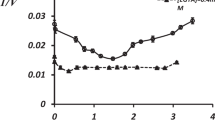Abstract
The binding of [14C]phenobarbital into synaptosomal plasma membranes of dog brain follows a sigmoid path. The “best fit” curve of this binding is the one described by the Hill equation (r 2>0.93 and Hill coefficient,n=1.32). (Na+, K+)-stimulated ATPase and Ca2+-stimulated ATPase activities are modulated by phenobarbital. Arrhenius plots of (Na+, K+, Mg2+)-dependent ATPase revealed that phenobarbital (2mM) lowered the transition temperature and altered the Arrhenius activation energies of this enzyme. The allosteric inhibition by F− of the (Na+, K+)-stimulated ATPase was studied in control and phenobarbital-treated membranes. The lowering of the transition temperature and changes in Arrhenius activation energy about the transition temperature in combination with changes observed in the allosteric properties of the (Na+, K+)-stimulated ATPase by F−, produced by phenobarbital, would be expected if it is assumed that phenobarbital “fluidizes” synaptosomal plasma membranes.
Similar content being viewed by others
References
Alivisatos, S. G. A., Deliconstantinos, G., Papaphilis, A., andTheodosiadis, G., 1981. Cooperative nature of the binding of cholesterol onto synaptosomal plasmal membranes of dog brain. Biochim. Biophys. Acta 643:642–649.
Alivisatos, S. G. A., Deliconstantinos, G., andTheodosiadis, G., 1981. Specificity of binding of cholesterol, steroid hormones and other compounds in synaptosomal plasma membranes and their effect on ouabain sensitive ATPase. Biochim. Biophys. Acta 643:650–658.
Deliconstantinos, G., andRamantanis, G., 1982. Evoked effects of oestradiol on hepatic cholesterol 7α-hydroxylase and drug oxidase in castrated rats. Int. J. Biochem. 14:811–815.
Deliconstantinos, G., Anastasopoulou, K., andKarayanakos, P., 1983. Modulation of hepatic microsomal Ca++-stimulated ATPase and drug oxidase activities of guinea pigs by dietary cholesterol. Biochem. Pharmacol. 32:1309–1312.
Deliconstantinos, G., andRamantanis, G., 1983. Alterations in the activities of hepatic plasma membrane and microsomal enzymes during liver regeneration. Biochem. J. 212:445–452.
Papahadjopoulos, D. K., Jacobson, G., Poste, G., andShepherd, G., 1975. Effect of local anesthetic on membrane properties. I. Changes in the fluidity of phospholipid bilayers. Biochim. Biophys. Acta 394:504–519.
Dipple, I., Gordon, L. M., andHouslay, M. D., 1982. The activity of 5′-Nucleotidase in liver plasma membranes is affected by the increase in bilayer fluidity achieved by anionic but not cationic drugs. J. Biol. Chem. 257:1811–1815.
Harvey, S. C., 1980, Hypnotics and sedatives: The barbiturates. Pages 349–365,in Goodman, L. S. andGilman, A. (eds.), The Pharmacological Basis of Therapeutics, 6th Ed. Macmillan, New York.
Papaphilis, A., andDeliconstantinos, G., 1980. Modulation of serotonergic receptors by exogenous cholesterol in the dog brain synaptosomal plasma membrane. Biochem. Pharmacol. 29:3325–3327.
Miller, G. I., 1959. Protein determination for large numbers of samples. Anal. Chem. 31:964–968.
Fiske, C. H., andSubbarow, Y., 1925. Colorimetric determination of inorganic phosphorus. J. Biol. Chem. 66:375–400.
Akera, T., andCheng, V. K., 1977, A simple method for the determination of affinity and binding site concentration in receptor binding studies. Biochim. Biophys. Acta 470:412–423.
Lenaz, G., Curatola, G., andMasotti, L., 1975, Perturbation of membrane fluidity. J. Bioenerg. 7:223–229.
Farias, R. N., 1980. Membrane cooperative enzymes as a tool for the investigation of membrane structure and related phenomena. Adv. Lipid. Res. 17:241–283.
Shinitzky, M., andBarenholz, Y., 1978. Fluidity parameters of lipid regions determined by fluorescence polarization. Biochim. Biophys. Acta 515:367–394.
Pastuszko, A., 1980. Action of barbiturates on activity of acetylcholinesterase from synaptosomal membranes. Neurochem. Res. 5:769–776.
Gordon, L. M., Saurheber, R. D., Esgate, J. A., Dipple, I., Marchmont, R. J., andHouslay, M. D., 1980. The increase in bilayer fluidity of rat liver plasma membranes achieved by the local anesthetic benzyl alcohol affects the activity of intrinsic membrane enzymes. J. Biol. Chem. 255:4519–4527.
Franks, N. P., andLieb, W. R., 1982. Molecular mechanisms of general anaesthesia. Nature 300:487–493.
Author information
Authors and Affiliations
Rights and permissions
About this article
Cite this article
Deliconstantinos, G. Phenobarbital modulates the (Na+, K+)-stimulated ATPase and Ca2+-stimulated ATPase activities by increasing the bilayer fluidity of dog brain synaptosomal plasma membranes. Neurochem Res 8, 1143–1152 (1983). https://doi.org/10.1007/BF00964928
Accepted:
Issue Date:
DOI: https://doi.org/10.1007/BF00964928




